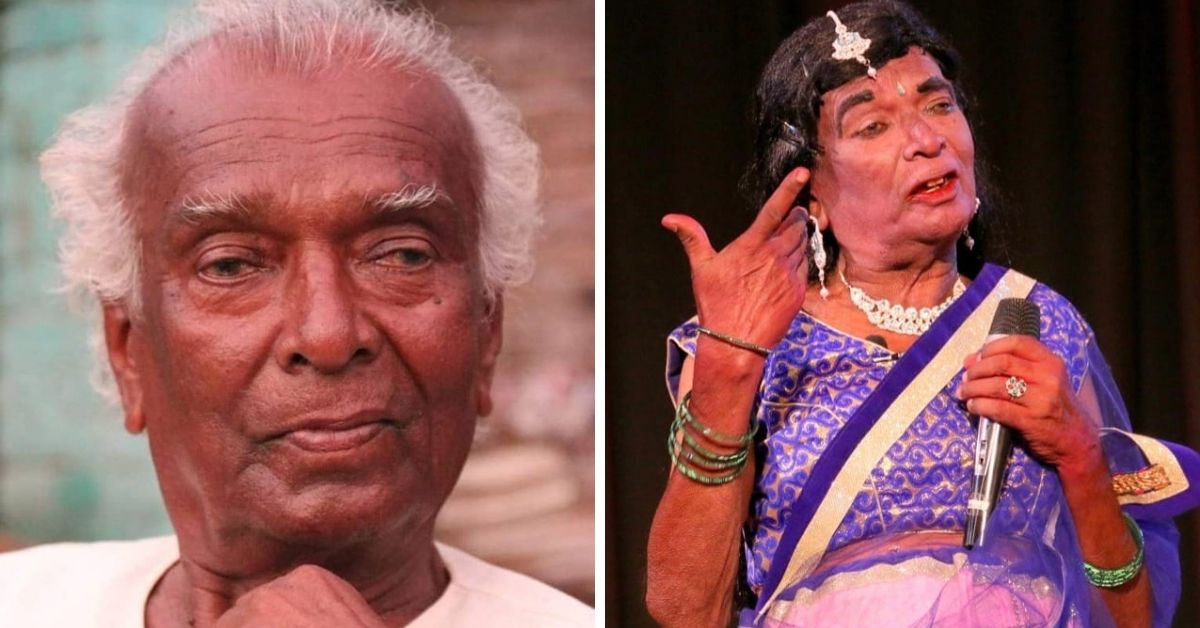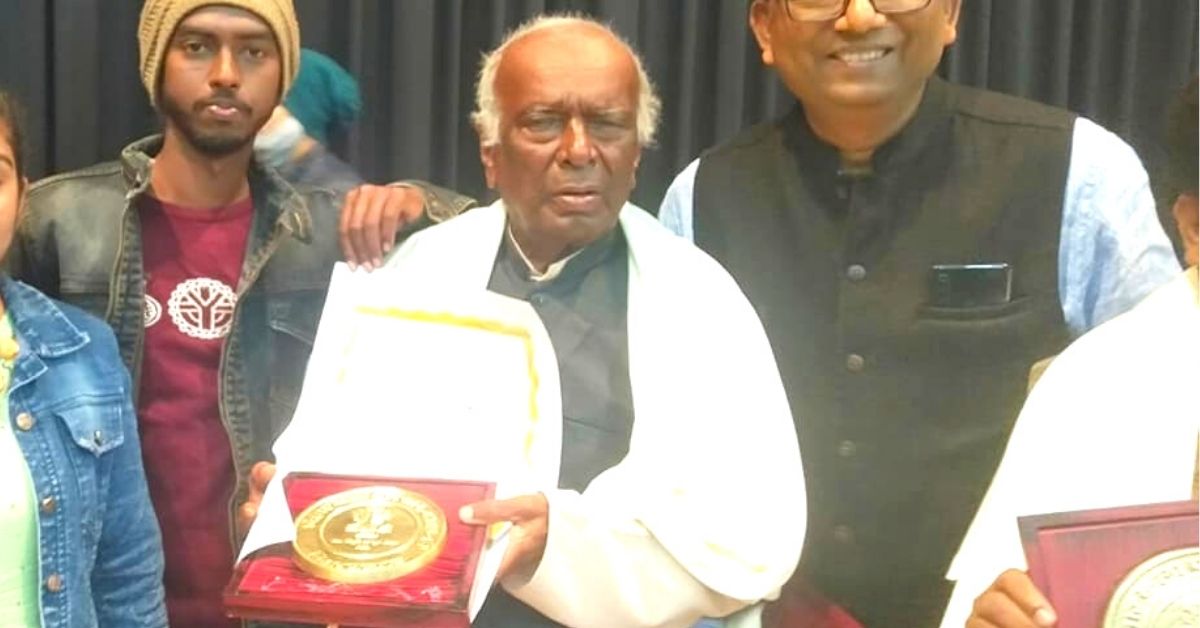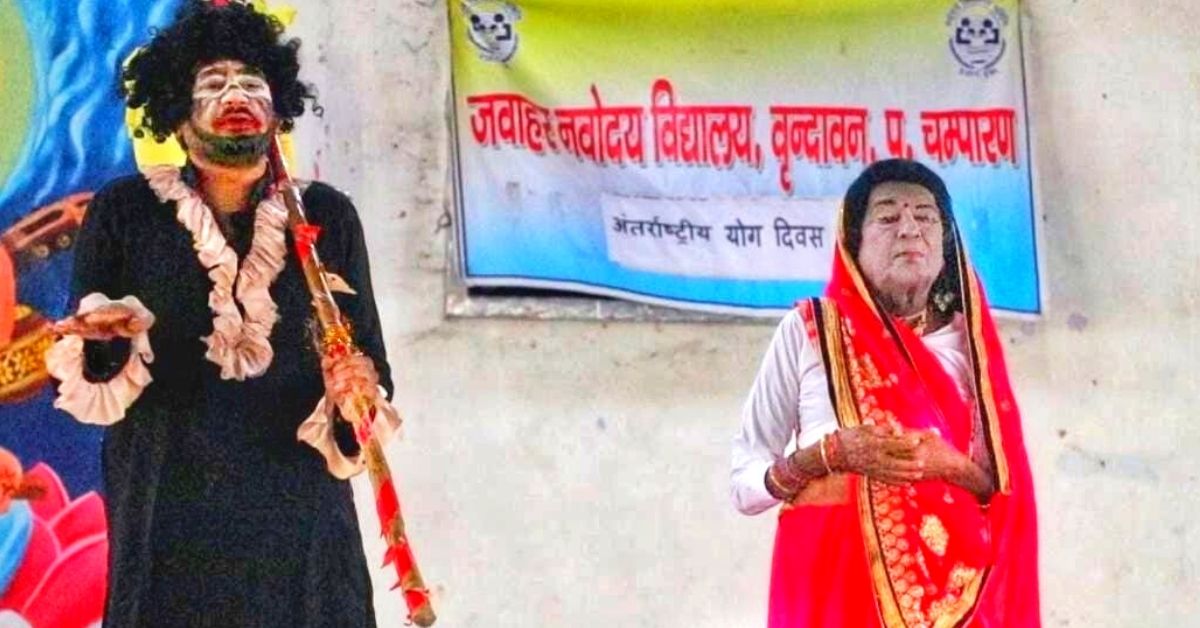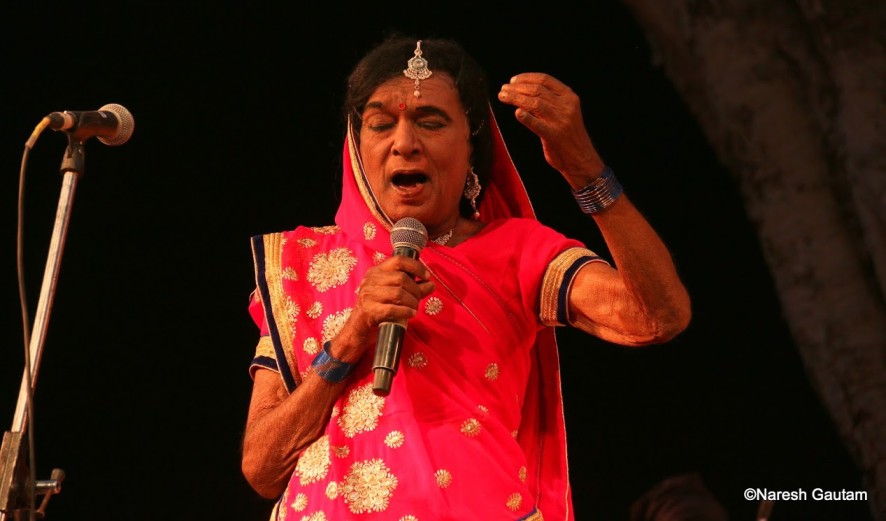They Taunted Him For His ‘Naach’. 84 Years Later, India Awarded Him the Padma Shri
Bihar's Ramchandra Manjhi has overcome gender and caste-based prejudices, financial crisis and several other odds to keep ‘Naach’ alive. He narrates what it is like to be a 'cross dresser' in his career spanning eight decades.

Ramchandra Manjhi may have won the Padma Shri, India’s fourth-highest civilian award and Sangeet Natak Akademi, but his biggest achievement is something else.
A resident of Bihar’s Chapra district, he has been performing ‘Naach’, a musical theatre performance for the last 84 years. His ability to perform on stage with the same zeal and passion despite his weak eyesight and age-related ailments, occupies the number one spot in his list of accomplishments.
Just a month ago, the 97-year-old had donned a ghagra choli, did his own make-up and delivered an arresting performance in West Champaran on World Yoga Day. While performing he may have lost his balance and not achieved the near-perfect thumka but his eyes, voice and body language as a sautan (mistress) in Bidesiya, a popular play written by late Bhikari Thakur, received a standing ovation.
By the end of the day, he was a completely different person — a knowledgeable grandfather leading conversations on current political and social affairs with his neighbours in the village. The transition from a grandfather to a woman yearning for love while dealing with societal pressures comes as a shock to many and that for him is his biggest award.

Ramchandra joined the performing arts when he was barely 10. At the time, Naach had just started to flourish in the hinterlands of Bihar and money was good so his parents didn’t mind if their son was a cross-dresser. In fact, the by-products of theatrical performance—money and fame—made it honourable.
Unfortunately, this wasn’t how the world was going to perceive Naach. The visible caste barriers sprung up and dethroned the artform from its reputed position. However, Ramchandra kept at it for this was not just his livelihood but also a medium of change.
This is probably the reason why, even at this age, Ramchandra gets ecstatic every time he has to essay a woman.
“I have done Naach all my life. It is my identity. Performance is part of any artist’s routine just like brushing teeth. Naach has been there for me at every stage of my life, and my reasons to do it have evolved with each passing decade — starting from money, pleasure, joy, spreading awareness to now preserving this dying art form,” Ramchandra tells The Better India.
He is presently associated with the Bhikhari Thakur Repertory Training & Research Centre, a troupe run by Dr Jainendra Dost, a JNU scholar in Performing Arts.
“Ramchandra is one of the four living legends who can pass on his craft to the younger generations. He is not only performing for us but also spreading his wisdom and skills to others to keep Naach alive,” Dost says.
History of ‘Launda Naach’

Contrary to popular belief, Naach (meaning ‘dance’) is not a traditional folk dance of Bihar. It is the equivalent of Jaatra, Tamasha or Nautanki, where a troupe performs on ancient folklores and current social conditions to preserve their heritage while educating people in an entertaining fashion. In Naach, female characters are portrayed by the male who cross dress as women.
These men are known as ‘laundas’, meaning — young boys.
However, the story behind how ‘Launda Naach’ came to be associated as a vulgar art form lies in India’s deep-rooted caste system.
“In the Indian cultural context, tawaifs (courtesans) have held significant importance in palaces and mansions of the kings and lords of the Mughal era. It is believed that the period of Baiji Naach arrived after the tawaifs. Landlords and moneylenders were the main organisers of Baiji Naach during special occasions such as marriage ceremonies and festivals. While this catered to the higher strata of society, Naach performed by men was popular among the lower and middle-class in the villages. It is believed that the term launda (male performer) was used to differentiate it from baiji (female performer),” Dost writes in his 2017 paper on Naach, Launda Naach.
As most themes of Launda Naach revolve around oppression faced by the Dalits and people from lower castes, it was not well-received by the upper caste. For instance, in Lakhdev Ram’s play Ghurva Chamaar (1965), a Dalit man is allowed to enter a temple after he tells the priest he has gold coins to offer. However, he is brutally assaulted when the Queen realises a Dalit has stepped inside the temple.
Such storylines, Dost says, prompted the feudal system to degrade Naach. While it is true that the performances have a touch of erotica in them, it is only a strategy to keep the audience engaged throughout the show that goes on all night.
Coming to the structure of Naach, it is conducted on a wooden stage with live musicians playing the harmonium, naquara, dholak, tabla, jhal and sarangi. There is a small tent attached at the back that doubles up as a make-up room and storage.
“Naach begins around 8 pm with a prayer followed by songs in Bhojpuri, solo dance, group dance, a commentary on social or political satire. The play begins around midnight and goes on till 4-5 am. The reason behind keeping the shows so late is that in the past, villagers would travel for miles to catch the show but returning late in the night was not an option. Secondly, the audiences that predominantly comprise masons, wage labourers, domestic workers, farmers, etc, were available only late in the evening,” Dost says.
He adds, “Naach is performed only by invite on special occasions like birthdays, funerals, weddings and so on. The significance of Naach is such that some politicians like Lalu Prasad Yadav have used it to connect with the communities. People from all strata of society appreciate the art form as long as the themes don’t ruffle feathers.”
Among the many playwrights that honed Naach over the decades, Bhikhari Thakur (1887-1971) deserves a special mention. He not only popularised the artform beyond Bihar in West Bengal and Assam but also delved into subjects like dowry, child marriage, migration, caste discrimination, domestic abuse, addiction, which were otherwise brushed under the carpet.
Plays such as Bidesia, Beti Bechwa, Ganga-Snan, Gabarghichor and Kaliyug- Prem, and songs such as Ramlila-Gaan, Budhshala ke Beyan advocated for individual’s rights.
Countering Normative Masculinity

Ramchandra’s singing talent was recognised by a family friend when he was 10. Upon asking if he could sing in front of a small audience, he delivered a fine job. That earned him a place in a local troupe and his parents were on board. At least someone would bring in the money, they thought. He tells me that dressing up as a woman for Naach was considered respectful in his community back then.
“The more I performed, the more I loved it. I felt like a magician with all eyes on me. Seeing their mesmerised faces, I thought I had the power to make them feel different emotions. The highlight of my performances would be people falling in the well or from a tree. That was our yardstick to know it was a full house,” says Ramchandra.
Dressing up as a woman and revealing his feminine side was never a problem. On the contrary, it is an honour to highlight the atrocities to women. “In my career spanning eight-decades, several men have come up to me and assured me that they will respect their wives, sisters and daughters more. Some even shed tears while I am performing. This is the power of any art form, it can undo years of customs and perceptions.”
Ramchandra may not realise it but by donning the ghaghra and being comfortable in his skin, he has countered the normative masculinity for years.
But he warns of a flip side.
“Either I am mocked for not being ‘a man’ or I am sexually harassed, sometimes even physically assaulted just because they see me as a woman. It tells a lot about our society. Men believe it is their prerogative to oppress the opposite gender. It is very common for men to poke bhalas (pointed weapons) on my stomach when I go near them to take the money.”
Over the years, Ramchandra has learnt to tackle such men. He even goes to the extent of sitting with them and explaining what they are doing is wrong. Likewise, opening up dialogues on child marriage and addiction is part of his after-performance. He claims people in his village have stopped selling their young daughters to older men.
For his most memorable performances, Ramchandra digs hard into his memory and narrates an incident that occurred in pre-Independence days.
“We were in Assam for a show to be staged in a theatre. Tickets were sold quickly and we had all the necessary permissions from the Britishers. The craze was such that people stopped watching movies for a few days to see us and this affected the revenue of theatre owners. They all ganged up on us and kicked us out of the city. On a more pleasant note, sharing a stage and wigs with yesteryear actresses like Helen, Suraya and Sadhana, is something I will never forget,” he says.
With the money earned from Naach, Ramchandra purchased a house, married off his siblings, and later, all his children. He now lives with his granddaughter in his village.
Ramchandra has overcome gender and caste-based prejudices, financial crisis and several other odds to keep his tradition alive. He believes that art is the only avenue to be inspired from and inspire countless others.
Edited by Yoshita Rao
If you found our stories insightful, informative, or even just enjoyable, we invite you to consider making a voluntary payment to support the work we do at The Better India. Your contribution helps us continue producing quality content that educates, inspires, and drives positive change.
Choose one of the payment options below for your contribution-
By paying for the stories you value, you directly contribute to sustaining our efforts focused on making a difference in the world. Together, let’s ensure that impactful stories continue to be told and shared, enriching lives and communities alike.
Thank you for your support. Here are some frequently asked questions you might find helpful to know why you are contributing?


This story made me
-
97
-
121
-
89
-
167













